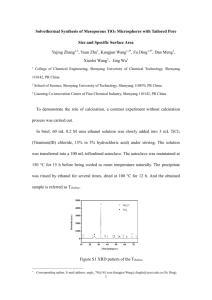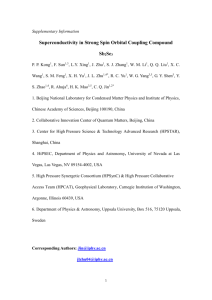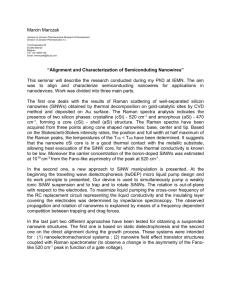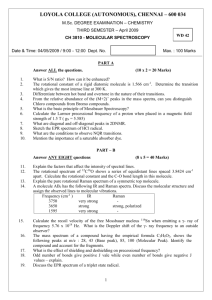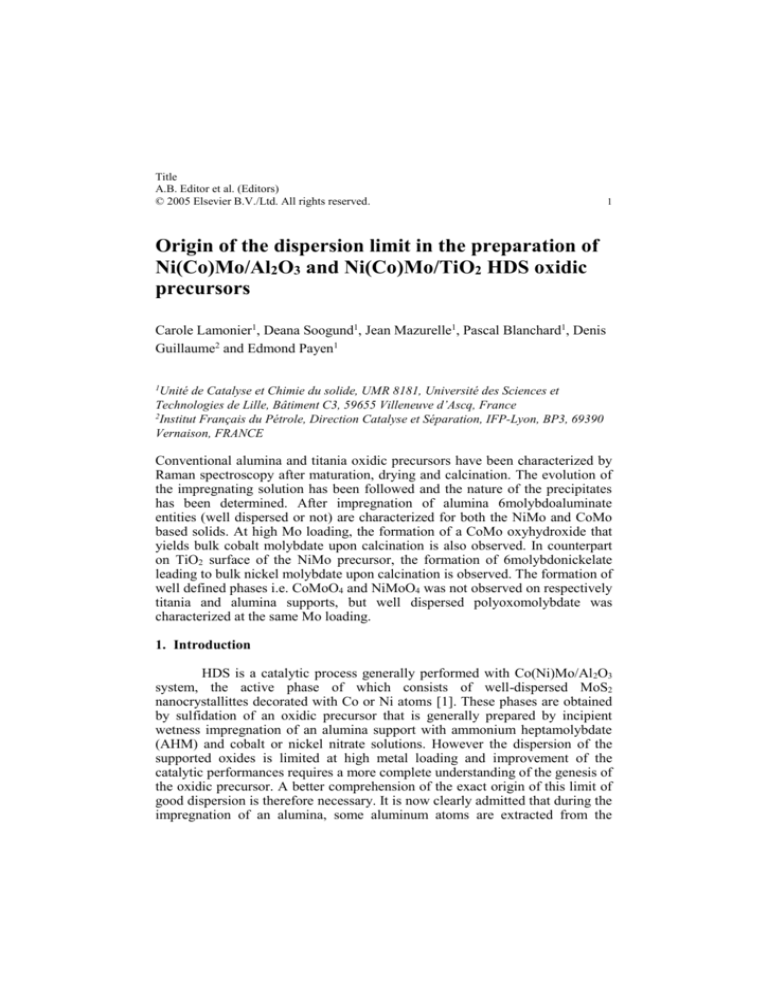
Title
A.B. Editor et al. (Editors)
© 2005 Elsevier B.V./Ltd. All rights reserved.
1
Origin of the dispersion limit in the preparation of
Ni(Co)Mo/Al2O3 and Ni(Co)Mo/TiO2 HDS oxidic
precursors
Carole Lamonier1, Deana Soogund1, Jean Mazurelle1, Pascal Blanchard1, Denis
Guillaume2 and Edmond Payen1
1
Unité de Catalyse et Chimie du solide, UMR 8181, Université des Sciences et
Technologies de Lille, Bâtiment C3, 59655 Villeneuve d’Ascq, France
2
Institut Français du Pétrole, Direction Catalyse et Séparation, IFP-Lyon, BP3, 69390
Vernaison, FRANCE
Conventional alumina and titania oxidic precursors have been characterized by
Raman spectroscopy after maturation, drying and calcination. The evolution of
the impregnating solution has been followed and the nature of the precipitates
has been determined. After impregnation of alumina 6molybdoaluminate
entities (well dispersed or not) are characterized for both the NiMo and CoMo
based solids. At high Mo loading, the formation of a CoMo oxyhydroxide that
yields bulk cobalt molybdate upon calcination is also observed. In counterpart
on TiO2 surface of the NiMo precursor, the formation of 6molybdonickelate
leading to bulk nickel molybdate upon calcination is observed. The formation of
well defined phases i.e. CoMoO4 and NiMoO4 was not observed on respectively
titania and alumina supports, but well dispersed polyoxomolybdate was
characterized at the same Mo loading.
1. Introduction
HDS is a catalytic process generally performed with Co(Ni)Mo/Al 2O3
system, the active phase of which consists of well-dispersed MoS2
nanocrystallittes decorated with Co or Ni atoms [1]. These phases are obtained
by sulfidation of an oxidic precursor that is generally prepared by incipient
wetness impregnation of an alumina support with ammonium heptamolybdate
(AHM) and cobalt or nickel nitrate solutions. However the dispersion of the
supported oxides is limited at high metal loading and improvement of the
catalytic performances requires a more complete understanding of the genesis of
the oxidic precursor. A better comprehension of the exact origin of this limit of
good dispersion is therefore necessary. It is now clearly admitted that during the
impregnation of an alumina, some aluminum atoms are extracted from the
2
C. Lamonier et al.
support and yield 6molybdoaluminate (AlMo6H6O24)3- (AlMo6) entities. These
Anderson heteropolystructures are well dispersed and/or precipitated on this
support according to the Mo loading [2]. This work therefore deals with the
extension of this dissolution/precipitation concept to the preparation of
Ni(Co)Mo catalysts. Extension of the study to titania supported oxidic precursor
will also be considered as it has been shown that TiO2 [3] supported MoS2
catalysts present 3 to 5 times higher hydrodesulphurization and hydrogenation
activities than alumina supported ones with an equivalent Mo loading per nm2
[4]. However the synergy between Co(Ni) and Mo in the TiO2 supported
catalyst appears to be lower than in the alumina supported one [5].
In this work, we will first study the stability of conventional CoMo and NiMo
impregnating solutions. NiMo and CoMo oxidic precursors have been prepared
by incipient wetness impregnation of alumina and titania supports. They will
be characterized at each step of the preparation by Raman spectroscopy.
Characterization results will be discussed by reference to the chemistry of the
impregnating solution which will allow us to explain the differences between
CoMo and NiMo based catalysts.
2. Experimental
2.1. Raman spectroscopy
The Raman spectra of the samples, maintained at room temperature,
were recorded using a Raman microprobe (Infinity from Jobin - Yvon),
equipped with a photodiode array detector. The exciting laser source was the
532 nm line of a Nd-YAG laser. The wavenumber accuracy was 2 cm-1
2.2. Oxidic precursors preparation
The samples were prepared by incipient wetness impregnation of the
support with (AHM + cobalt nitrate) and (AHM + nickel nitrate) aqueous
solutions. The Mo concentration was adjusted taking into account alumina and
titania pore volumes that are respectively 0.8 and 0.4 mL.g-1 in order to prepare
catalyst with Mo loadings corresponding to 10, 14 and 16 MoO3 wt % on
alumina. On titania the maximum content on molybdenum that can be obtained
is 10 MoO3 wt %. Note that in this case the TiO2 supported solid has 3,5 Mo
atoms per nm2 as obtained for a Al2O3 supported one with a molybdenum
content of 16 MoO3 wt %. After two hours of maturation, the solids were dried
under air at 95°C and then calcined at 500°C for 4 h under oxygen. The samples
will be designated according to the starting solution and the support as follows
XNiMoy/TiO2, X being the molybdenum loading expressed as a weight
percentage of MoO3 and y being the Co(Ni)/Mo ratio.
Origin of the dispersion limit in the preparation of Ni(Co)Mo/Al2O3 and
Ni(Co)Mo/TiO2 HDS oxidic precursors
3. Results and Discussion
3.1. Stability of the Co or Ni based impregnating solutions
The stability of impregnating solutions has been studied by LRS at
different Mo concentrations. The Co/Mo and Ni/Mo ratio studied are 0.17 and
0.5. From a catalytic point of view 0.5 is the optimum value [6] whereas the
former one (0.17) is the ratio corresponding to the stoechiometry of the
Anderson molybdocobaltate or Anderson molybdonickelate [XMo6H6O24]nheteropolyanion. Figure 1 shows the Raman spectra of these CoMo and NiMo
solutions before precipitation. They exhibit the characteristic lines of the
heptamolybdate anions in solution with the main lines at 942, 895 and 364 cm-1,
the line at 1050 cm-1 corresponding to nitrate anions. Whereas the Mo and
CoMo solutions are relatively stable without any precipitation before several
hours, a precipitation is rapidly observed for the NiMo based solutions,
whatever the metal loading and the Ni/Mo ratio.
Fig. 1 : Raman spectra before precipitation of
(a) CoMo solution and (b) NiMo solution
Fig. 2 : Raman spectra of (a) precipitate from a
NiMo solution (b) NiMo6H6O24(NH4)3
Anderson solid and (c) the NiMo filtered
solution
Figure 2 presents the Raman spectra of the precipitate and of the filtered Ni
based solution. The Raman spectrum of the filtered solution with a main line at
960 cm-1 is assigned by reference to literature data [7] to condensed
isopolymolybdate as [Mo8O26]4-. Such a formation is in agreement with the
4
C. Lamonier et al.
decrease of the pH observed upon addition of nickel nitrate in the HMA
solution. Indeed for a Ni/Mo ratio equal to 0.5 the pH solution decreases from
5.7 until 3.5. The precipitate obtained by filtration is sky-blue and its Raman
spectrum is similar to the Anderson anion [NiMo6H6O24]4- as shown in figure 2
in which the spectrum of the ammonium salt is also reported. The main features
characteristic of the Mo-O2t (where t stands for terminal) and of the Mo-O-Ni
bonds appear respectively at 935 and 568 cm-1.
Precipitation of a CoMo solution is only observed after several hours. The
Raman spectrum of the precipitate (not reported here) clearly exhibits the
features of HMA for Co/Mo=0.17 whereas for the highest Co/Mo=0.5 the
spectrum is also characteristic of condensed isopolymolybdate species in
agreement with the pH decrease of the solution. This study indicates that no
Anderson heteropolyanion is formed. Indeed some discrepancies appeared in the
literature concerning the existence of the molybdocobaltate [CoMoO24H6]4-,
HPA in which the oxidation state of the central heteroatom is +2. Indeed La
Ginestra [8] reported its formation whereas Nomiya [9] proposed later that the
Co(II) should be excluded from the Anderson family and that such structure
should enter into another category of heteropolyanion, this compound being
likely [Co(H2O)6-x(Mo7O24)]4- as proposed by Malik and al. [10]. Thus in
impregnating solution containing cobalt, our results indicate that a cobalt
Anderson based heteropolyanion, with cobalt at the oxidation state 2+, is not
formed in our preparation conditions. At high metal loading a precipitation
occurs and the precipitate corresponds to HMA and/or Mo8O26(NH4)4 mixture
according to the pH solution whereas in the case of nickel the [NiMo6H6O24]4HPA is most probably formed in solution but due to the low solubility of its
ammonium salt a precipitation occurs.
3.2. Deposition on alumina support
3.2.1. Unpromoted alumina supported oxidic precursors
It has been shown through a Raman, NMR and Mo K-edge EXAFS
spectroscopic study, that upon impregnation of alumina with AHM solution a
decomposition occurs with extraction of aluminium atoms of the support
[11,12] and their inclusion in the Anderson HPA AlMo6O24H63- [3,13]. These
AlMo6 entities are well dispersed and/or precipitated on this support according
to the Mo loading [3]. For an incipient wetness impregnation, the highest Mo
loading is governed by the maximum solubility of the AHM and therefore it
depends on the pore volume of the alumina. However as the solubility of AlMo6
ammonium salt is lower than the AHM one, the precipitation of this salt is
observed at high Mo loading.
Origin of the dispersion limit in the preparation of Ni(Co)Mo/Al2O3 and
Ni(Co)Mo/TiO2 HDS oxidic precursors
3.2.2. Alumina supported promoted oxidic precursors
Raman spectra of the promoted matured (not reported here) and dried
samples exhibit the features of well dispersed AlMo6 entities for NiMo (figure
3) and CoMo (figure 4 (b)) based solids. For the NiMo solids, whatever the Mo
loading, 10, 14 or 16 MoO3 wt %, the Raman spectra only present a main line
at 948 cm-1 and a line around 563 cm-1 in the domain of Mo-O-Al vibrations,
attesting the homogeneity of the surface species.
Fig. 3 : Raman spectra after drying of (a)
16NiMo0.5/Al2O3 (b) 14NiMo0.5/Al2O3
and (c) 10NiMo0.5/Al2O3
Fig. 4 : Raman spectra of CoMo0.5/Al2O3 after
drying (a) 16CoMo0.5/Al2O3, (b) and (c)
14CoMo0.5/Al2O3 (different particles)
Heterogeneities are highlighted at high Mo loading for the CoMo based
precursor. Indeed other features in figure 4 (c) (930 and 850 cm-1) are also
observed that have been assigned to the formation of a mixed CoMo
oxohydroxide phase whereas the precipitation of the AlMo6 ammonium salt is
noticed in these CoMo at high Mo loading (16MoO3 wt %), figure 4 (a). Upon
calcination this heterogeneity is confirmed. After transfer in the air the well
dispersed AlMo6 entities are restored. But the Raman spectrum of the calcined
CoMo solid (not reported here) also exhibits, after transfer in wet air, the line
characteristic of the (a)CoMoO4 phase (940 and 818 cm-1) that should originates
from the CoMo oxyhydroxyde precipitate as it is not observed at lower Mo
loading for which no heterogeneity was evidenced on the dried solid. For a
16CoMo/Al2O3 catalyst MoO3 phase is detected with the lines at 995 and 819
cm-1 its formation originates upon calcination from the (NH4)3AlMo6O24H6
crystallites deposited at the alumina surface after drying. As far as the NiMo
dried solid are concerned, no heterogeneity appears even at
high Mo loading and after calcination whatever the molybdenum content the
Raman spectra (not reported here) show only the main line characteristic of the
6
C. Lamonier et al.
well dispersed polymolybdate phase (a large line at 950 cm-1). The absence of
MoO3 and/or NiMoO4 phase after calcination confirms the good dispersion of
molybdenum.
3.3. Deposition on titania support
3.3.1. Unpromoted titania supported oxidic precursors
The
Raman
spectra of unpromoted
sample in the dried and
calcined
state
are
presented on figure 8
together with the spectrum
of
the
support.
In
agreement with literature
data [14], the spectrum of
the titania support (figure
5 (c)) exhibits the three
well resolved lines at 316
(B1g), 597 (A1g) and 638
cm-1 (Eg) that are also
observed on the oxidic
Fig. 5 : Raman spectra of (a) 10Mo/TiO2 after calcination
(b) 10Mo/TiO2 after drying and (c) TiO2 support
precursor spectra. At the dried step for the unpromoted solid (figure 5 (b)) the
AHM features are no longer observed and the broad line at 950 cm-1 shows the
formation of a well-dispersed polymolybdate phase whose structure is not yet
clearly established. This phase has also been reported by Ng and Gulari [4] and
defined as octahedrally coordinated polymeric Mo species. In this spectrum (see
the zoom) line is noticed at 975 cm-1 that could be assigned to a protonated
form of Mo8O264- [7] the formation of which can be explained by the acidity of
TiO2 support. Upon calcination (figure 5 (a)) this line becomes greater and the
Raman spectrum is shifted towards higher wavenumbers but no MoO3 phase is
detected, attesting the good metal dispersion.
3.3.2. Promoted titania supported oxidic precursors
Raman spectra of NiMo/TiO2 and CoMo/TiO2 in the dried and calcined
state are reported figure 6 in which only the 700-1200 spectral range is
presented. Whatever the state of the solid, we note a high similarity between
the spectra of CoMo/TiO2 and Mo/TiO2 (figure 5). Unlike the CoMo/Al2O3, in
CoMo/TiO2 solids cobalt does not interact strongly with the support to form
well defined bulk or subsurface Co-TiO2 phase. However literature data
indicates that as Mo support interaction is lower on titania than on alumina,
Origin of the dispersion limit in the preparation of Ni(Co)Mo/Al2O3 and
Ni(Co)Mo/TiO2 HDS oxidic precursors
addition of cobalt suppresses the formation of MoO3 and leads to the formation
of cobalt molybdate [5,15]. But controversy about the role of titania can be
found. Indeed Ng and Gulari described TiO2 as a strongly interacting support
[4]. In our case neither CoMoO4 nor MoO3 features are observed in the Raman
spectra after calcination (figure 6 (a)). The 10CoMo/TiO2 catalyst has the same
Mo coverage (3,5 atoms of Mo/nm2 ) as the alumina one on which the
formation of cobalt molybdate is observed. We can therefore consider that its
absence on the CoMo/TiO2 one is due to the homogeneity of deposition during
the impregnation. The formation of CoMo oxyhydroxide is not noticed on
titania for a same metal
concentration
of
the
impregnating solution. The
NiMo system differs from the
CoMo one. After drying, the
Raman spectrum of the
10NiMo/TiO2 (figure 6(e))
exhibits the characteristic
lines of the NiMo6 entities
(936, 920 and 887 cm-1). After
calcination Raman lines at
960 and 913 cm-1 (figure
6(c)) indicate the formation of
(b)NiMoO4 species according
Fig. 6 : Raman spectra of TiO2 supported oxidic precursors (a) 10CoMo0.5/TiO2 after calcination,
(b) 10CoMo0.5/TiO2 after drying, (c) and (d) 10NiMo0.5/TiO2 after calcination (different
particles) and (e) 10NiMo0.5/TiO2 after drying
to the literature references [14]. Moreover a well dispersed molybdate phase is
also noticed on the calcined NiMo based precursor, corresponding to the line at
948 cm-1 (figure 6(d)). These results are in agreement with UV-DRS study of
Wei et al [16] in which the authors deduced that in NiMo/TiO2-Al2O3 catalysts
the Ni2+ ions were located in an octahedral environment and yield NiMoO4-like
phase upon calcination.
4. Conclusion
For alumina CoMo and NiMo supported oxidic precursors the same
trend is observed. Raman analysis evidences the formation of a well dispersed
AlMo6 phase after the maturation and drying steps whichever the promoter
atom. However at high Mo loading other phases are observed for CoMo based
8
C. Lamonier et al.
solids such a CoMooxyhydroxide and AlMo6 ammonium precipitate. They yield
respectively CoMoO4 and MoO3 phases upon calcination. In the case of NiMo
solids, molybdenum and nickel remain well dispersed on alumina from the
maturation to the calcination step even at high metal loading.
On titania the behavior of nickel and cobalt solids is rather different. After
drying, on one hand we observed with NiMo solids the formation of NiMo 6
precipitate whereas on the other hand no heteropolyanionic phase CoIIMo6 is
formed, isopolymolydate phase being well dispersed on CoMo solids. These
differences are reflected in the calcined state. After calcination, a NiMoO4
phase is noticed besides a dispersed molybdate phase for NiMo oxidic
precursor. This study clearly shows that the chemistry of the impregnating
solutions and the solubility of the ammonium AlMo6 and NiMo6 entities
determine the nature of the species formed at the surface of the precursors at
high Mo loading and subsequently determine the limit of dispersion of the metal
atoms. Improvement of catalytic performances can be obtained by using
impregnating solutions without ammonium counter ion. We therefore propose
the use of a new precursor, a cobalt salt of [Co2Mo10H4O38]6- that has been
proved as an efficient starting material [17].
REFERENCES
1. Topsoe, H.; Candia, R.; Topsoe, N. Y.; Clausen, B. S. Bull. Soc.Chim. Bel. 1984, 93, 783-806.
2. Le Bihan, L.; Blanchard, P.; Fournier, M.; Grimblot, J.; Payen, E. J. Chem. Soc., Far. Trans.
1998, 94, 937-940.
3. Okamoto, Y.; Ochiai, K.; Kawano, M.; Kobayashi, K.; Kubota, T. Appl. Catal., A: General
2002, 226, 115-127..
4 Ng, K. Y. S.; Gulari, E. J. Catal. 1985, 92, 340-54.
5. Ramirez, J.; Fuentes, S.; Diaz, G.; Vrinat, M.; Breysse, M.; Lacroix, M. Appl.Catal. 1989, 52,
211-23.
6. Rob van Veen, J. A.; Gerkema, E.; Van der Kraan, A. M.; Knoester, A. J. Chem. Soc., Far.
Trans. Communications 1987, 1684-6.
7. Wang, L.; Hall, W. K. J. Catal. 1980, 66, 251-5.
8. La Ginestra, A.; Giannetta, F.; Fiorucci, P. Gazzetta Chimica Italiana 1968, 98, 1197-212.
9. Nomiya, K.; Takahashi, T.; Shirai, T.; Miwa, M. Polyhedron 1987, 6, 213-18.
10. Malik, A.; Zubaili, S. A.; Khan, S. J. Chem. Soc. Dalt. transaction 1977, 1049.
11. Payen, E.; Plazenet, G.; Martin, C.; Lamonier, C.; Lynch, J.; Harle, V. Stu. Surf. Sci. Cata.
2002, 143, 141-148.
12. Plazenet, G.; Payen, E.; Lynch, J.; Rebours, B. J. Phys. Chem. B 2002, 106, 7013-7028.
13. Carrier, X.; Lambert, J. F.; Che, M. J. Am. Chem. Soc. 1997, 119, 10137-10146.
14. Dzwigaj, S.et al, Appl. Catal., B 2003, 41, 181-191.
15. Leliveld, R. G.; Van Dillen, A. J.; Geus, J. W.; Koningsberger, D. C. J. Catal. 1997, 171, 115129.
16. Wei, Z. B.; Yan, W.; Zhang, H.; Ren, T.; Xin, Q.; Li, Z. Appl. Catal., A 1998, 167, 39-48.
17. Lamonier, C.; Martin, C.; Mazurelle, J.; Harlé, V.; Guillaume, D. Appl. Catal. B, under press
2006.


